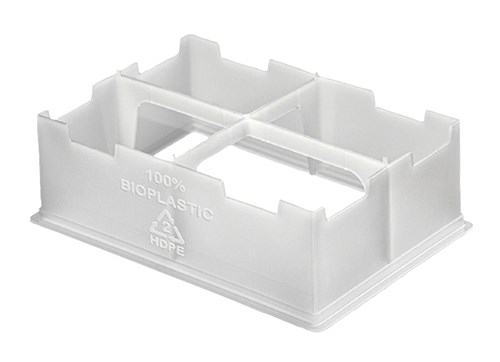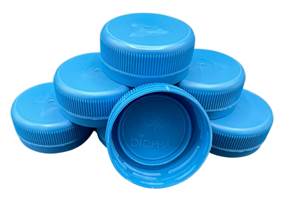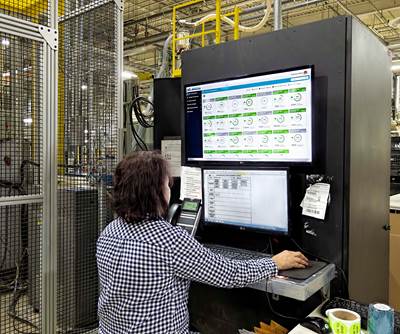Switch to Bioplastic Helps Molder ‘Go Green’
Labcon opts for surgarcane-derived HDPE to make its packaging more earth-friendly.
A move to a new line of biobased materials is helping a global manufacturer of laboratory disposable products further improve the sustainability of its product line. Labcon North America, Petaluma, Calif., recently switched to a “green” plastic for its “Earth-Friendly” labware-products packaging, and the result has been improvements in recyclability and manufacturing efficiency over previously used biomaterials.
The material, “I’m Green” HDPE from Braskem of Brazil (U.S. office in Philadelphia), is produced from sugarcane ethanol. The material is used for Labcon’s low-carbon-footprint Eclipse pipette-tip refill system. The injection molded tip base of the refill package is made of this material, which can be recycled with conventional HDPE streams.
“Our end-users, as scientists, understand the need to reduce environmental impacts and consumption of the world’s limited resources, says Mark Gmelin, Labcon materials R&D engineer. “Braskem’s material helped us improve the product’s footprint, increase production efficiency, and provide a better end-of-life solution through recycling.”
Unlike the compostable PHA bioplastic previously used by Labcon, the Braskem HDPE has a life-cycle assessment (LCA) with certified CO2 footprint. For each ton of “green” HDPE produced, the material sequesters 2.15 tons of CO2 from the atmosphere. In contrast, typical polyolefins emit to the environment two times their own weight of CO2. Since “green” HDPE processes just like a traditional HDPE, it requires no drying, and cycle times are less than half those of the PHA part it replaced.
Labcon started focusing on disposable plastic labware in the 1980s. Its 80,000 ft² facility is equipped with 60 injection machines from 50 to 200 tons. It molds over 3 million pipette tips and about 1 million centrifuge tubes a day. Nearly 95% of these products are PP-based, with the rest (caps, for example) made of HDPE.
As Gmelin explains, the molder’s push toward sustainability began in 1994, when it opted to replace its PS packaging with recyclable paperboard and began selling its scrap plastic instead of landfilling it. These developments were accompanied by energy conservation and extensive on-site solar power generation. Today, all of its regrind is used in-house to make packaging components.
In 2007, the company developed an innovative pipette tip-refill system—consisting of 10 layers of pipette tips in a minimalist package with an integrated tip-loading device. This unique packaging motivated Labcon to consider bioplastics as part of its sustainable design, which includes recyclable paperboard, in-house regrind, and post-consumer PET.
Initially, Labcon chose PHA. “We opted for the more robust PHA over other bioplastics,” explains Gmelin. As he points out, the refill package base has thin walls (0.04-in) and dimensions of 3 x 5 x 2 in. with small alignment tabs that need to hold up well and withstand elevated temperatures during shipping.
Among the reasons Labcon switched materials is that the LCA didn’t look good once it started molding PHA parts. Most of its domestic and global customers have easy access to recycling operations, but not to industrial composting facilities. Moreover, there was a problem with material availability at times. In addition, the PHA—unlike PLA and Braskem’s HDPE—did not have third-party environmental certification, which Labcon’s customers often require.
Labcon plans to use Braskem’s “green” polyolefins for more molded parts in the future.
Related Content
Impacts of Auto’s Switch to Sustainability
Of all the trends you can see at NPE2024, this one is BIG. Not only is the auto industry transitioning to electrification but there are concerted efforts to modify the materials used, especially polymers, for interior applications.
Read More‘Monomaterial’ Trend in Packaging and Beyond Will Only Thrive
In terms of sustainability measures, monomaterial structures are already making good headway and will evolve even further.
Read MorePHA Compound Molded into “World’s First” Biodegradable Bottle Closures
Beyond Plastic and partners have created a certified biodegradable PHA compound that can be injection molded into 38-mm closures in a sub 6-second cycle from a multicavity hot runner tool.
Read MoreMultilayer Solutions to Challenges in Blow Molding with PCR
For extrusion blow molders, challenges of price and availability of postconsumer recycled resins can be addressed with a variety of multilayer technologies, which also offer solutions to issues with color, processability, mechanical properties and chemical migration in PCR materials.
Read MoreRead Next
Beyond Prototypes: 8 Ways the Plastics Industry Is Using 3D Printing
Plastics processors are finding applications for 3D printing around the plant and across the supply chain. Here are 8 examples to look for at NPE2024.
Read MoreLead the Conversation, Change the Conversation
Coverage of single-use plastics can be both misleading and demoralizing. Here are 10 tips for changing the perception of the plastics industry at your company and in your community.
Read MorePeople 4.0 – How to Get Buy-In from Your Staff for Industry 4.0 Systems
Implementing a production monitoring system as the foundation of a ‘smart factory’ is about integrating people with new technology as much as it is about integrating machines and computers. Here are tips from a company that has gone through the process.
Read More

















